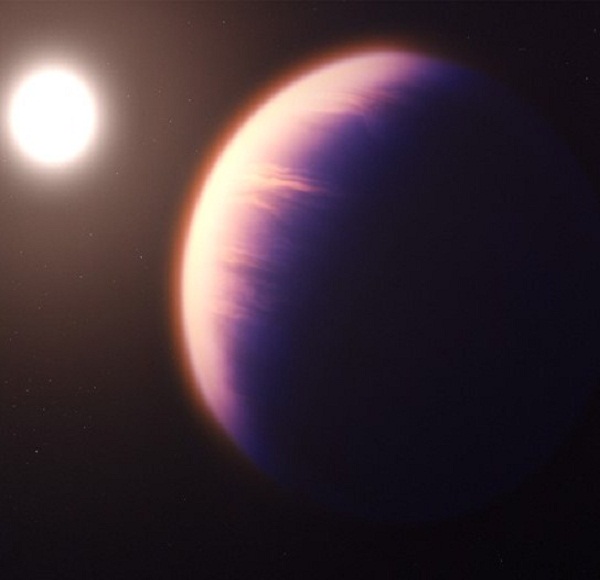The first clear evidence for the existence of carbon dioxide in the atmosphere of a planet outside the solar system has been found by Nasa’s James Webb Space Telescope.
The finding suggests that Webb may be able to detect and measure carbon dioxide in the thinner atmospheres of smaller rocky planets too.
WASP-39 b is a hot gas giant with a mass roughly one-quarter that of Jupiter (about the same as Saturn) and a diameter 1.3 times greater than Jupiter. Its extreme size is related in part to its high temperature (about 900°C).
Unlike the cooler, more compact gas giants in our solar system, WASP-39 b orbits very close to its star – only about one-eighth the distance between the Sun and Mercury – completing one circuit in just over four Earth days.
The planet’s discovery, reported in 2011, was made based on ground-based detections of the subtle, periodic dimming of light from its host star as the planet transits, or passes in front of the star.
Previous observations from other telescopes, including Nasa’s Hubble and Spitzer space telescopes, revealed the presence of water vapour, sodium, and potassium in the planet’s atmosphere. But Webb’s unmatched infrared sensitivity has now confirmed the presence of carbon dioxide on this planet as well.
During a transit, some of the starlight is eclipsed by the planet completely (causing the overall dimming) and some is transmitted through the planet’s atmosphere.
Because different gases absorb different combinations of colours, researchers can analyse small differences in brightness of the transmitted light across a spectrum of wavelengths to determine exactly what an atmosphere is made of. With its combination of inflated atmosphere and frequent transits, WASP-39 b is an ideal target for transmission spectroscopy.
The research team used Webb’s Near-Infrared Spectrograph (NIRSpec) for its observations of WASP-39b. In the resulting spectrum of the exoplanet’s atmosphere, a small hill between 4.1 and 4.6 microns presents the first clear, detailed evidence for carbon dioxide ever detected in a planet outside the solar system.
“As soon as the data appeared on my screen, the whopping carbon dioxide feature grabbed me,” said Zafar Rustamkulov, a graduate student at Johns Hopkins University. “It was a special moment, crossing an important threshold in exoplanet sciences.”
No observatory has ever measured such subtle differences in brightness of so many individual colours across the 3 to 5.5-micron range in an exoplanet transmission spectrum before, Nasa said. Access to this part of the spectrum is crucial for measuring abundances of gases like water and methane, as well as carbon dioxide, which are thought to exist in many different types of exoplanets.
Although only fully operational for a few months, the James Webb telescope has already taken a picture of the cosmos considered to be the most detailed yet as well as discovering details about the atmosphere of Jupiter.
Source: E&T










